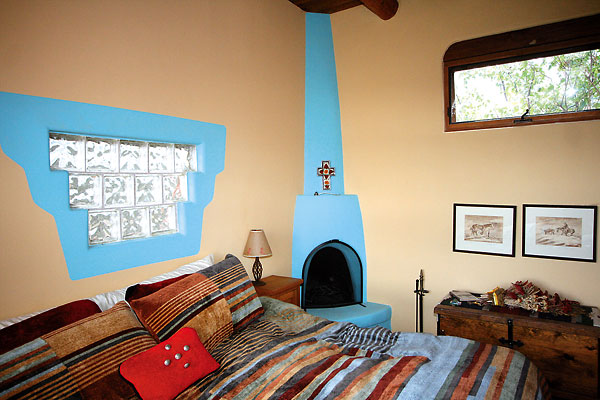
What better place for writer Johnny D. Boggs and realtor Lisa Smith to live than the outskirts of Santa Fe, New Mexico, at the edge of a greenbelt?
They live close enough to the city for shopping excursions and good food, far enough away that son Jack has plenty of room to hike and play.
Drawing inspiration from the Pueblo Indians and the Colonial Spanish, their Pueblo Revival home—a popular regional style of architecture in Santa Fe—features three bedrooms, two baths and two living areas at 2,200 square feet on almost two acres. Located off a dirt road, the home is surrounded by Southwestern landscaping that includes piñon and juniper trees, cholla cactus, Hot Lips sage, Jupiter’s Beard, sedum, yarrow and purple mums.
Their home fits perfectly into the New Mexico landscape. The interior is a blend of bright Southwestern colors like turquoise and tomato red accented by Johnny’s custom boots and hats, and Lisa’s collection of crosses.
Every room features a ceiling inspired by old-century Spanish architecture of the Southwest. The den offers a coved ceiling, which curves upward and is rounded at the corners. Two of the ceilings in the bedrooms feature vigas, which are logs supporting the roof. The living room offers up vigas and latillas, which are peeled sticks laid between the vigas. The kitchen gets a splash of color on its ceiling: tomato red.
The Spanish Mission style is also revived in the Boggs’s home in their choice of tile for the flooring. Throughout most of the house, you’ll find Saltillo tile complete with “dog prints” on some of the tile (as saltillo dries in the Mexican sun, dogs routinely walk over the not quite dry tiles, leaving their marks). The kitchen floor is dressed up in colorful talavera Mexican tile.
Dramatic views from the back patio of the Sangre de Cristo and Jemez mountain range will top off a day of writing or even hiking since a convenient trail begins at the back gate leading to an arroyo.
As inviting as the outdoors are, the interior of this home is both decorative and livable. You’ll find baseball caps, awards, Indian relics and even a small bench from the Ozarks, purchased when Lisa and Johnny were still dating—and in which that romantic Johnny hid her engagement ring when he popped the question.
Accent pieces include a Chimayó weaving that hangs in the hallway, a sculpture of a mother, father and child that was a gift to Lisa from her dad when Jack was born, plus movie posters and lobby cards that Johnny purchased on e-Bay when Lisa wasn’t watching. She got even though and purchased a lamp at Lots of Furniture—her favorite place to shop in Dallas—“as a present to myself after leaving a dead end and absurdly dysfunctional job.”
Among their collection: a vintage Remington typewriter Lisa bought at an antique shop in Dallas (she notes that Johnny still misses his manual Smith-Corona), a Winchester ammo box, some bottles, a Civil War replica belt, horns and an “Angry Mob” toy collection a friend gave Johnny because he thought it might come in handy for research. Lisa says, “Johnny’s friend is quite insane.” Of course now we have to figure out just which of Johnny’s friends she may be referring to … can’t be me as all I’ve ever bought Johnny were drinks.
As you might imagine in a writer’s house, most everything has a story behind it, or is connected to a friend. Two pieces of art in the master bedroom and two in the front hallway are by ol’ Max Evans (author of The Rounders, The Hi-Lo Country and dozens of other recognized works), who once made his living as a Taos artist. Acrylic paintings by Nocona and Quanah Burgess (descendants of Quanah Parker, the last chief of the Quahadi Comanches, see p. 26) hang in the den. Lisa has artwork signed to her by Denver artist Carrie Fell.
Johnny has collected a Gros Ventre sheath and Southern Cheyenne pouch, both purchased at Santa Fe Indian Market, plus a Comanche bow and arrow and Santo Domingo quiver, purchased at the What Not Shop in Cerrillos, New Mexico. He bought a Crow shield in South Dakota, a Cherokee tomahawk in Oklahoma and a wooden Eastern Woodland Indian quiver at an estate sale in Texas.
Johnny’s Wrangler Award, received from the National Cowboy and Western Heritage Museum for his novel Spark on the Prairie, is displayed in the den along with his Spur Award-winning books: Camp Ford and Doubtful Cañon. In his office, which is totally too neat for a writer, books are stacked and stuffed into cases that have other important items: two of his Kansas City Royals ball caps (he has three) and his ball cap from Century Bank, which represents his tenure as assistant coach for Jack’s Little League baseball team.






